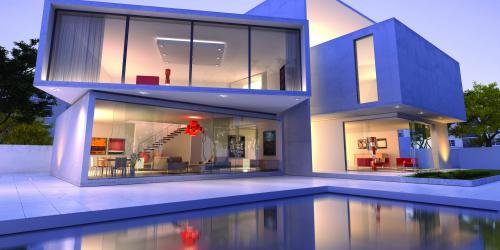What is the sound?
Sound can be a beautiful thing—until it isn’t! Music can inspire passion, but loud jackhammers can be jarring and disruptive. Controlling sound as it passes through glass can be both an art and a science. There are, however, some helpful guidelines when designing a space with acoustics in mind. Eastman offers a portfolio of Saflex® Acoustic PVB interlayers that can help improve and control sound in any building. Here are some measurement tools that you can use to understand how these interlayers can help bring serenity to any space.
STL ratings—the basics
Sound can be classified by its movement through mediums, whether glass, drywall, or any other construction material. We often think of sound as intensity and pitch, which can be measured. It’s also possible to measure how much sound changes as it passes through a material. Sound transmission loss (STL) is determined by sending known sound from one room through the material being tested to another room where the change in sound is measured.
These tests are typically done at the one-third octave band frequencies, yielding data used in contour-fitting procedures, calculations, or comparative methodologies to achieve single-number ratings.
These single-number ratings can be helpful in the selection of a glazing configuration for a window system. A contour fitting procedure can determine weighted sound reduction (Rw), Rw adaptation terms for pink noise and urban traffic (C and Ctr respectively), or sound transmission class (STC) ratings. Performance above the contour (elevated sound transmission loss) is not considered for these ratings. Sometimes, good performance is left undiscovered.
Outdoor/indoor transmission class (OITC) is a weighted calculation initially meant to monitor outside-to-inside noise levels, but it offers a compressed number of ratings for glass. This makes it sometimes difficult to discern improvements based on this number alone.
Designing with complex glazing configurations
When using high-performance interlayers such as Saflex Acoustic PVB interlayers, additional methodologies may be useful. The decibel reduction (DRb) is a comparative rating methodology that reveals the sum of all decibel differences between a baseline 3-mm (0.125 inch) monolithic glass and the identified glass configuration (the 3-mm baseline was developed after years of testing). For all ratings, a higher number indicates better acoustic performance. The rating frequency range is 80–5000 Hz. Any deficiencies and benefits are accounted for in the calculation. There is no additional weighting; the number is meant to aid in the selection of products when you cannot discern between the Rw, STC, or OITC ratings as well as give an idea of performance vs. a 3-mm glass baseline.
The following graph shows the deviation of a nominal 6-mm laminated glass vs. the 3-mm baseline. In the example, the laminated glass keeps an additional 114 decibels over the analyzed range from going through the glass vs. the 3-mm control.
When using Saflex Acoustic (Q series) PVB interlayers in laminated glass, the DRb is typically 100–300 or more units. This indicates very effective sound damping, suggesting that you can achieve noise control by including this type of glass in your windows, facades, doors, and skylights.
We recommend that you review the one-third octave band transmission loss data for any system where specific performance requirements are needed, as single number ratings do not always portray the actual experienced performance of the glazing system.










